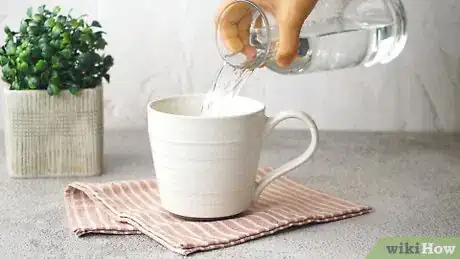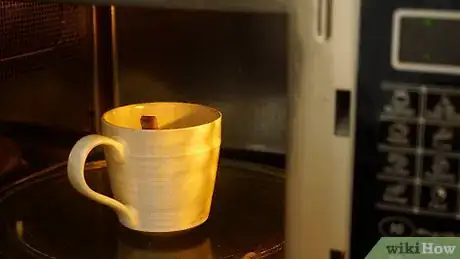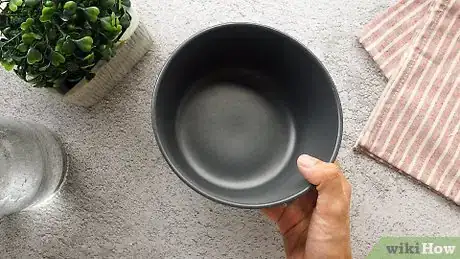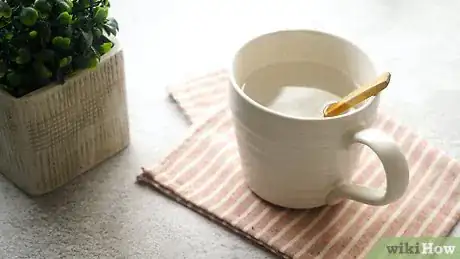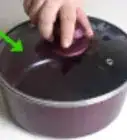wikiHow is a “wiki,” similar to Wikipedia, which means that many of our articles are co-written by multiple authors. To create this article, 38 people, some anonymous, worked to edit and improve it over time.
The wikiHow Culinary Team also followed the article's instructions and verified that they work.
This article has been viewed 1,377,525 times.
Learn more...
Need some boiling water for a beverage or culinary project? Small amounts of water can be conveniently boiled in the microwave in minutes, without the trouble of heating water on the stove or turning on the electric kettle. However, this isn't without its own difficulties. For instance there is a small, but real risk of super-heating, in which the hot water erupts suddenly, possibly causing burns. While this is unlikely[1] , there are precautions to help boil the water safely.
- Prep time: 1 minute
- Cook time: 1-3 minutes
- Total time: 2-4 minutes
Steps
Boiling Water Safely
-
1Pour the water into a microwave-safe cup or bowl. Boiling water with a microwave is remarkably easy. To start, pour the water into a container made of the microwave-safe materials listed above.
- Make sure the container is not sealed shut. A buildup of hot steam can cause a harmful explosion.
-
2Place a clean, microwave-safe object in the water. Next, put a non-metallic object such as a wooden spoon, a chopstick, or a popsicle stick in the water. This prevents a dangerous problem called "super-heating" by giving the water something to form bubbles on.
- Super-heating occurs when water in the microwave heats water past its boiling point and the water is unable to form bubbles because there are no nucleation sites (essentially rough spots for the bubbles to form on). As soon as the water is disturbed or a nucleation site is introduced, the built-up superheated water forms steam very quickly, causing a small explosion of boiling water.[5]
- If you don't have any non-metallic objects to put in your water, use a container that has a scratch or chip on the interior surface. This will act as a nucleation site to help the water bubble.
-
3Put the water in the microwave. Heat in short (e.g., no more than one and a half minute) intervals, stirring regularly until the water is steaming. Even if these steps are followed, bubbling may not be obvious as it would be on the stove. The most accurate way to ensure the water is boiling is to use a thermometer. At sea level, water boils at (212° F; 100° C); this temperature decreases at higher altitudes.
- If you're using a container that holds heat well (like a glass or ceramic one), be careful when you take the water out of the microwave to stir it. Use a towel or potholder to protect yourself from burns as you handle it.
-
4To sterilize water, keep it boiling. If you're boiling water to purify it, heat it in the microwave long enough to kill the microorganisms. The Centers for Disease Control and the Environmental Protection Agency recommend boiling the water for at least one minute, or 3 minutes at altitudes above 6,562 feet (>2000 m).[6]
Avoiding Superheating Hazards (More Tips)
-
1Don't heat the water for excessively long stretches. If, after reading the advice in the section above, you're worried about a superheating accident when you try to boil water, don't worry — there's more you can do to keep yourself safe. For instance, perhaps the single biggest thing you can do to avoid the risk of superheated water is to not heat it for long periods of time. If your water isn't heated past its boiling point, it can't become superheated.
- The exact amount of time you'll want to limit your heating sessions to can vary based on the strength of your microwave. To be safe, try limiting your heating to a single one-minute segment at first. Based on how hot the water gets from this first heating attempt, you can adjust your next one accordingly.
-
2Avoid extremely smooth containers. For the same reason that it it's a good idea to add something non-metallic to your water or to use a container with scratches in it, it's a bad idea to use perfectly smooth containers. Examples of these can often include new, pristine glass and ceramic bowls, though a variety of other materials can also be smooth enough to cause problems.
- Instead, use an older, more worn container or one with visible scratches at the bottom — these will create nucleation sites for bubbles to form.
-
3Carefully tap the side of the container when it finishes heating. Once you believe you've heated your water long enough to get it hot, check for superheating by firmly tapping on the side of the container before you take it out of the microwave. Ideally, this should be done with a long tool to protect your hands.
- If the water is superheated, tapping the container can cause it to suddenly "burst" over the top. This may spill water into the microwave, but since you haven't removed it yet, you should avoid any burns.
-
4Stir the hot water with a long object while it is in the microwave. Still not sure whether the water is superheated or not? Stir it with a long rod or stirring stick to know for sure. Introducing an object and disturbing the water gives it nucleation sites to form bubbles — if it is superheated, it will rapidly burst or boil over. If it doesn't, congratulations! Your water is safe.
-
5Keep your face away from the container until you are sure it is safe. This may seem like it goes without saying, but it's important not to put your face anywhere near water that you think may have even a tiny risk of being superheated. Most injuries from superheated water result when a person removes the water from the microwave and looks into the container — a sudden burst of superheated water at this point can cause serious burns on the face and even permanent vision damage in the worst of cases.
Community Q&A
-
QuestionIs it safe to boil water in the microwave?
 wikiHow Staff EditorThis answer was written by one of our trained team of researchers who validated it for accuracy and comprehensiveness.
wikiHow Staff EditorThis answer was written by one of our trained team of researchers who validated it for accuracy and comprehensiveness.
Staff Answer wikiHow Staff EditorStaff AnswerThe main risk of boiling water in a microwave is that it might become superheated, which can cause boiling water to violently “explode” out of the container. If you use precautions such as putting a wooden stirrer in the water or using a container with a rough inner surface, you’re less likely to experience this issue.
wikiHow Staff EditorStaff AnswerThe main risk of boiling water in a microwave is that it might become superheated, which can cause boiling water to violently “explode” out of the container. If you use precautions such as putting a wooden stirrer in the water or using a container with a rough inner surface, you’re less likely to experience this issue. -
QuestionCan I boil water and then put macaroni in it to cook in the microwave?
 Community AnswerYou can put both water and macaroni in a bowl before heating, ensuring the noodles are covered completely by water, and cook it in the microwave for about seven to eight minutes. You might want to put a plate under the container, as it might bubble over.
Community AnswerYou can put both water and macaroni in a bowl before heating, ensuring the noodles are covered completely by water, and cook it in the microwave for about seven to eight minutes. You might want to put a plate under the container, as it might bubble over. -
QuestionWhat else can a microwave do?
 Community AnswerThe main use for microwaves is to reheat food faster than possible in a stove or oven. There are many recipes and products that are made specifically for use in a microwave.
Community AnswerThe main use for microwaves is to reheat food faster than possible in a stove or oven. There are many recipes and products that are made specifically for use in a microwave.
Warnings
- A mug of water without something in it, like a chopstick, has a much higher risk of superheating because the bubbles have nowhere to gather. Putting something in with the water is a small but really important step.⧼thumbs_response⧽
- Do not put a sealed container of water in the microwave. The expanding water vapor can cause the container to burst open, creating a huge mess!⧼thumbs_response⧽
References
- ↑ http://www.snopes.com/science/microwave.asp
- ↑ http://www.realsimple.com/food-recipes/tools-products/cookware-bakeware/food-containers-safe-for-microwave
- ↑ http://www.iflscience.com/technology/what-happens-when-you-put-metal-microwave
- ↑ http://lifehacker.com/what-should-and-shouldnt-i-microwave-1532532172
- ↑ http://www.snopes.com/science/microwave.asp
- ↑ http://wwwnc.cdc.gov/travel/yellowbook/2010/chapter-2/water-disinfection.aspx
About This Article
If you want to boil water in the microwave, pour the water into a microwave-safe container. Add a clean, microwave-safe object like a wooden spoon or a popsicle stick into the water to prevent it from super-heating, which may cause the water to erupt suddenly. Heat the water in short intervals of no more than one and a half minutes, stirring regularly until the water is steaming. If you don’t see bubbles, use a thermometer to monitor when the water reaches 212°F. Keep reading for more tips on how to avoid super-heating the water.
